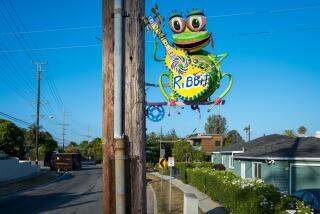Second Death Mars Christo’s Art Exhibit : Umbrellas: A crane operator is electrocuted while dismantling a giant parasol in Japan.
- Share via
A crane operator was electrocuted in Japan Thursday while dismantling a portion of Christo’s giant umbrellas project there, the second death in less than a week linked to the bi-continental exhibit.
Masaaki Nakamura, 51, was killed after the boom from his crane was jolted by a 66,000-volt power line as he prepared to remove one of the 1,340 blue umbrellas from the Ibaraki Prefecture north of Tokyo, Christo officials said.
The Bulgarian-born environmental artist ordered the umbrellas to come down in Japan and in the Tejon Pass above Los Angeles after the death Saturday in Lebec of 33-year-old Lori Keevil-Mathews of Camarillo. Authorities said she died when one of the 1,760 yellow umbrellas, which had been torn loose by wind, hit her and slammed her into a boulder.
The tragic and premature end to what would have been a three-week display has led to speculation that the artist may have difficulty siting future exhibits, which require a multitude of approvals from government agencies and property owners.
“I would say that it might be harder because there are always people opposed to his project, wherever he goes, and I suppose they will just seize on something like this to argue their case,” said Calvin Tomkins, an art critic and historian who has written extensively about Christo for The New Yorker magazine.
Christo and his wife, Jeanne-Claude Christo-Javacheff, flew from Los Angeles to Japan after hearing of Nakamura’s death, leaving behind a statement saying they wanted to “be with their friends in Japan . . . to share the sorrow brought by the accidental death of a fellow worker.”
On Thursday, Christo ordered all dismantling activities to stop for one day in Nakamura’s honor. He wanted “to pay tribute to the accident and to give everybody a rest,” said Wolfgang Volz, the project photographer.
The California wing of “The Umbrellas: Joint Project for Japan and USA” required advance approval from Los Angeles and Kern counties, several state agencies and 29 landowners. Several of those who gave Christo permission to erect the umbrellas said they based their decisions partly on references from past projects such as the “Running Fence,” which stretched across 24 1/2 miles of Sonoma and Marin counties in 1976.
“We made contact with other agencies, for example Sonoma County, to get information about just exactly how he works,” said Ted James, Kern County planning director. “It certainly helped to build up our confidence with the exhibit.”
Michael Cullen, a U.S. citizen working in Berlin on Christo’s proposed “Wrapped Reichstag” project, was alarmed to learn of the second death.
“This is terrible news,” said Cullen, who has been working since 1972 to get approval to wrap the former parliament building in synthetic fabric. “Of course it is too early to know, but I think it will make it at least a little more difficult.”
In New York, Christo hopes some day to place about 11,000 fabric and steel gates along Central Park walkways despite a 1981 rejection by then-parks Commissioner Gordon J. Davis. A city parks spokesman said the deaths in California and Japan would “certainly be a problem” in any future considerations.
Davis wrote in his rejection that he was worried about the “substantial unknown risk inevitable in such a venture” in a park used by thousands daily.
However, several people involved in approving the umbrellas project said they would still give Christo a good reference despite the deaths.
“Our experience, in terms of all our dealings with him, has been very positive, very productive and fun,” said Jack Hunt, president of the 270,000-acre Tejon Ranch, where more than half the yellow umbrellas stood.
He said the accident that killed Keevil-Mathews could have happened as easily elsewhere in the area during Saturday’s storm. “It is horrible that this tragedy happened, but she could have been in Ft. Tejon Park watching the Civil War re-enactment” and have a tree fall on her, he said.
Taizo Watanabe, senior spokesman for the Ministry of Foreign Affairs in Japan, said the “positive and constructive side (of ‘The Umbrellas’) should not be forgotten” in the wake of Nakamura’s death. But, he said, “I will look into the details of why this incident happened and whether it was in the realm of human control or beyond it.”
Christo attorney Scott Hodes acknowledged that staff members are concerned about the impact of the deaths on future projects, although he said unless the artist is found legally liable, that impact should be minimal.
“Realistically, yes, it would have somewhat of an effect,” Hodes said. “But we are maintaining that in both instances we were not at fault.”
Nakamura worked for a subcontractor hired by Muto Construction, the contractor used by Christo in Japan, and all of the subcontractors were required to carry their own liability insurance, Hodes said. The Japanese valley where the umbrellas were located is “filled with wires,” according to Volz, and workers had been warned to watch for them.
“This is more likely a case of negligence on the part of the operator of the crane,” Hodes said.
Henry Scott Stokes, the Japan project director, said the Tokyo Electric Power Co. line that killed Nakamura was less than 25 feet off the ground.
“You had someone on the site who was not deeply familiar with the area and an elemental mistake was made,” he said, speaking from the Japanese site.
In the case of Keevil-Mathews, Hodes maintains that the sudden strong winds were “an act of God” that could not have been anticipated or prevented. Keevil-Mathews’ family has not decided whether to file a lawsuit against Christo, although her mother-in-law said early this week that several attorneys had contacted them.
Times staff writer Teresa Watanabe contributed to this story from Japan.
More to Read
Sign up for Essential California
The most important California stories and recommendations in your inbox every morning.
You may occasionally receive promotional content from the Los Angeles Times.











